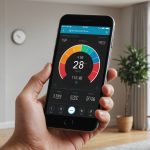Overview of Smartphone Baby Monitoring
In recent years, the rise of smartphone baby monitor solutions has revolutionised how parents ensure their child’s safety. Unlike traditional baby monitoring devices, smartphones offer a cost-effective, user-friendly alternative with advanced features. Modern baby monitoring solutions utilise an app that can be installed directly on your smartphone. These apps are designed to deliver real-time video, sound alerts, and even movement detection, creating a comprehensive monitoring system.
One of the significant benefits of smartphone monitoring is portability. Parents can keep an eye on their little ones from virtually anywhere, whether running errands or relaxing in a different part of the home. Moreover, the adaptability of these apps allows users to customise alerts, ensuring the monitor functions precisely to their needs.
Also to discover : Transform Home Heating: Master Zone Temperature with Smartphone Precision
The market is expanding rapidly, with a remarkable trend toward incorporating AI technology, offering predictive analysis and more intuitive user interfaces. For those considering this innovative approach, ensuring the monitoring app includes encryption and advanced security features will be vital for safeguarding personal data and ensuring privacy. As these technologies continue to evolve, they provide increasingly powerful and versatile tools for new parents.
Setting Up Your Smartphone as a Baby Monitor
Transitioning to a smartphone baby monitor requires careful attention to setup, ensuring seamless operation and enhanced monitoring. This guide will walk you through essential configuration steps, from app installation to initial adjustments.
Topic to read : Transform Your Home Protection: Instantly Monitor and Respond with Real-Time Smartphone Alerts
Required Apps and Software
The process begins with selecting an appropriate app installation. Leading choices include Baby Monitor 3G, Cloud Baby Monitor, and Dormi. These apps provide essential features such as audio and video streaming. Pay attention to the compatibility with your device’s operating system to avoid functionality issues. Many apps support both Android and iOS, but double-check this before downloading.
Smartphone Compatibility
Before completing your setup, ensure that your device meets the necessary specifications. Not all smartphones support baby monitoring solutions effectively—devices must have a stable internet connection and a functional camera. Additionally, verify that your phone’s model allows running the app in the background without interruptions.
Initial Configuration Steps
Once the application is installed, launch it and follow the configuration steps. Each app usually includes a tutorial for setup, focusing on defining parameters like audio sensitivity and notification preferences. Set your device to “Do Not Disturb” mode during monitoring to prevent interruptions. Conduct a test run to confirm that your system operates smoothly before relying on it to monitor your baby.
Troubleshooting Common Issues
Diving into the realm of smartphone baby monitor technology can be rewarding, but it’s not without its challenges. When issues arise, knowing how to troubleshoot can make all the difference.
Connectivity and Network Issues
A prevalent problem is connectivity between the monitoring app and smart devices. Ensure your smartphone baby monitor is connected to a stable Wi-Fi network. If issues persist, resetting the router or switching to a 5GHz band might resolve interference problems. Always keep your device’s software and monitoring app updated to maintain compatibility and performance.
App Performance Problems
Performance hiccups in baby monitoring solutions often stem from outdated apps or software conflicts. Regularly check for app updates to gain new functionalities and bug fixes. If the app crashes frequently, try restarting your smartphone and closing background applications to free up resources. Increasing the app’s priority in your phone’s settings can also improve reliability.
Device Compatibility Concerns
Compatibility concerns can arise with specific phone models or operating systems. Verify that your device meets the configuration steps specified by the app developer. If issues continue, consulting online forums or contacting customer support can provide device-specific solutions. Understanding and addressing these matters leads to a seamless monitoring experience.
Security Considerations for Smartphone Baby Monitors
The security of personal data is paramount in the realm of smartphone monitoring. When utilising a mobile device for baby monitoring, you take essential steps to ensure that private information remains protected. One of the best practices involves choosing a monitoring app that employs robust encryption. Encryption ensures that data transmitted from your device is scrambled and only accessible by authorised users, effectively guarding against unauthorised access.
Moreover, routinely updating the monitoring app and your smartphone’s operating system enhances security. These updates frequently contain patches that resolve vulnerabilities, thereby preventing exploitation by cyber threats. Another critical factor is configuring your app to use strong passwords and, where available, enabling two-factor authentication to add an extra layer of protection.
Being aware of privacy concerns, especially when it comes to potential cyber attacks, can improve your overall security setup. Avoid using unsecured networks; opt for a trusted Wi-Fi connection instead. These proactive measures significantly reduce the risks associated with unsecured devices. By maintaining proper security protocols, you safeguard your family’s privacy and ensure a secure monitoring environment.
Additional Hardware Modifications
When enhancing baby monitoring solutions with a smartphone, certain baby monitor accessories can significantly augment functionality. External devices such as network cameras provide advanced features, allowing multiscreen viewing and improved video quality for detailed observation. This setup can be particularly useful in larger homes, offering comprehensive coverage that standalone smartphone apps might lack.
Positioning a smartphone baby monitor optimally is crucial. Investing in smartphone mounts or stands can ensure your device remains stable, providing clear visibility at ideal viewing angles. This hardware keeps the camera steady, preventing disconnections due to shifts or falls.
Additional hardware enhancements like infrared night lights can improve visibility during nighttime monitoring. These external devices enable low-light surveillance, offering parents peace of mind even in complete darkness. Integrating a microphone or speaker system allows for two-way communication, transforming the monitoring experience into an interactive one. This feature is critical for those wanting to soothe their child remotely while receiving responses clearly.
Together, these enhancements elevate the performance and usability of smartphone monitoring, making it a robust alternative to traditional systems. By combining digital apps with strategic hardware enhancements, parents can build a highly effective and customised monitoring setup.
Comparing Smartphone Baby Monitors with Traditional Options
Smartphone baby monitors have become increasingly popular with parents, offering notable advantages over traditional baby monitoring solutions. One of the primary distinctions lies in the flexibility and portability of smartphone options, which allows parents to monitor their children from virtually any location. Traditional monitors are often limited by range and device compatibility.
Key differences in functionality between these options also highlight the benefits of smartphone monitoring. Many apps provide enhanced features such as real-time video, sound alerts, and even motion detection, offering a comprehensive and customisable monitoring experience.
Cost analysis is another critical factor when comparing these options. While it may seem initially cost-effective to choose a traditional monitor, investing in a robust smartphone app can lead to long-term savings due to fewer hardware requirements and subscription only features similar to premium devices.
In terms of user satisfaction, smartphone monitors often outperform traditional systems because they integrate seamlessly with other smart devices. This accessibility encourages users to embrace technology, enhancing convenience. By understanding these contrasts, parents can make informed decisions, balancing affordability, functionality, and ease of use in their baby monitoring decision.
Real-Life Examples and Testimonials
Exploring real-life examples and testimonials offers unique insights into the practical use of smartphone baby monitors. These narratives provide valuable perspectives on transitioning from traditional solutions.
Success Stories
Many parents have embraced smartphone technology, boasting real-time video and sound alerts as game-changers. By utilising apps such as Baby Monitor 3G, they’ve experienced enhanced peace of mind, with easy accessibility while away from home. An example includes a family who praises the flexibility of monitoring their baby while on vacation, relying on their smartphone for consistent updates.
Challenges Faced
Despite the benefits, some users encounter difficulties, primarily with app issues like connectivity glitches and battery drain. One user cited interference when multiple devices connected to the network, which was resolved by switching to a stronger Wi-Fi band.
Lessons Learned
Experienced users recommend taking steps like proper configuration of settings and investing in smartphone mounts. These modifications secure the device, preventing disruptions. By sharing these lessons learned, parents foster a community of information exchange, aiding others in navigating potential challenges with ease and confidence. This collective knowledge helps optimise overall user experience, making smartphone monitoring a compelling choice for modern families.











